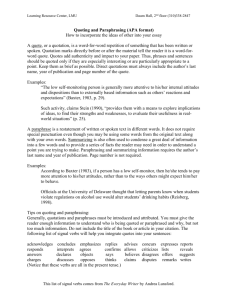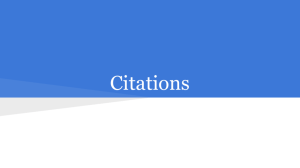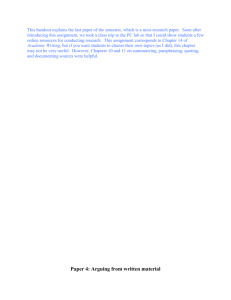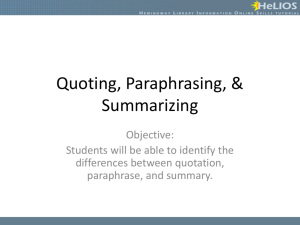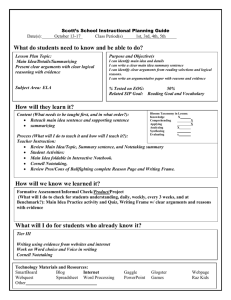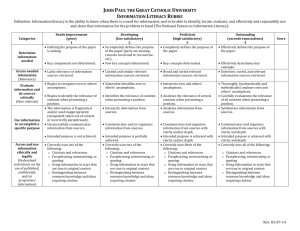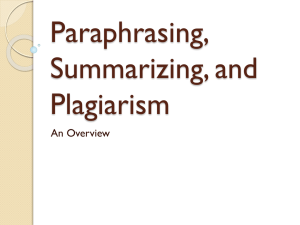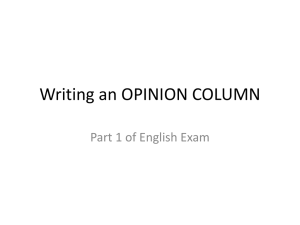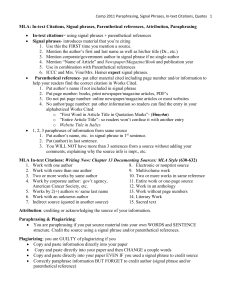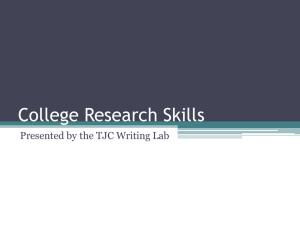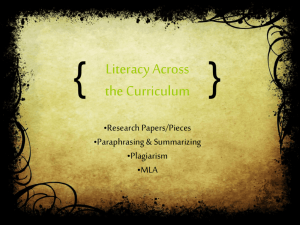Lesson 3: Taking Notes
advertisement
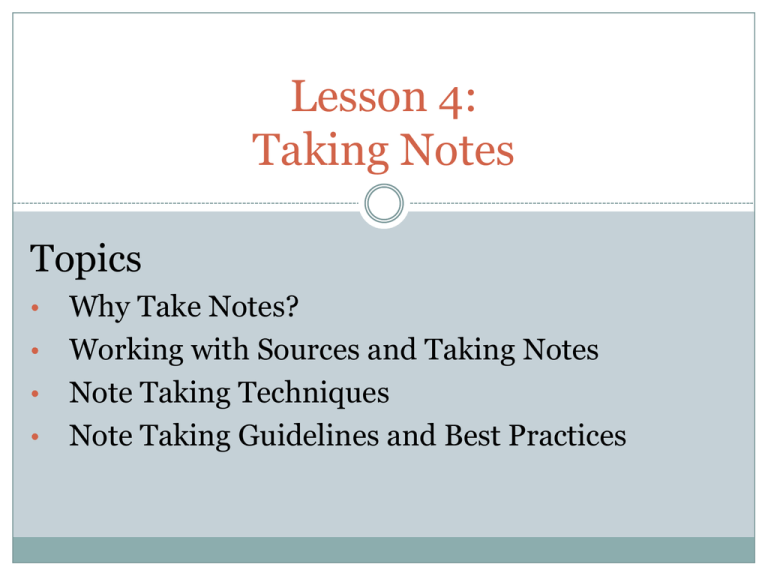
Lesson 4: Taking Notes Topics Why Take Notes? Working with Sources and Taking Notes Note Taking Techniques Note Taking Guidelines and Best Practices Why Take Notes While Notetaking can be time consuming, it’s a critical stage the research process. Why take notes? Notetaking begins the process of writing the paper. Good notes will speed the process of drafting the paper. Good notes will lead to a stronger finished product. ENGLISH COMPOSITION TWO Working with Sources and Taking Notes When working with sources, make information your own by: Quoting Sources Paraphrasing Summarizing ENGLISH COMPOSITION TWO Quoting Sources Reasons for quoting sources The author makes the point in an interesting way. The author is an expert who is widely recognized. Your paper is on a literary topic. The prose is unusual, surprising, or memorable. Rules for quoting sources Quote selectively Provide a context Follow up ENGLISH COMPOSITION TWO Paraphrasing Paraphrasing is restating information in your own words. Instead of directly quoting a source, try paraphrasing. Paraphrasing forces you to engage the information; it forces you to think. By paraphrasing, you are essentially writing part of the draft. ENGLISH COMPOSITION TWO Paraphrasing Guidelines Best practices for paraphrasing include: Read the source material several times. 2. Rewrite the material in your own words without looking at the original source. 3. Compare your rewrite to the original source. 1. Verify the rewrite is accurate and consistent with the intent of the source. Verify the rewrite is original and not just a reshuffling of words. ENGLISH COMPOSITION TWO Summarizing Summarizing is reducing longer material into a brief statement. Like Paraphrasing, summarizing requires thinking about the material Summarizing can include Main points Overviews Condensation Best practices for summarizing include: Ensure the summary captures the basic idea of the source As you draft, summarize often to avoid a string of undigested quotations. ENGLISH COMPOSITION TWO Note Taking Techniques Major note taking techniques include: The Double-Entry Journal The Research Log Narrative Notetaking Online Research Notebooks ENGLISH COMPOSITION TWO The Double Entry Journal The Double Entry Journal is a twocolumn entry in a notebook or Word document Top of the page contains bibliographic information for the source Left column contains notes from the source Right column contains your comments on what you collected from each source ENGLISH COMPOSITION TWO The Research Log To create a Research Log: 1. 2. 3. 4. Record the bibliographic information Write an open-ended response to the reading Mine the source for “nuggets” Write another open-ended response entitled “The Source Reconsidered” ENGLISH COMPOSITION TWO Narrative Note Taking The Steps in Narrative Notetaking: 1. 2. 3. Fastwrite a summary for at least one minute Skip a line and fastwrite the story of your thinking. Repeat Step 2 for another point ENGLISH COMPOSITION TWO Online Research Notebooks Several tools exist to help keep research notes online. Zotero Evernote Google Docs PDF Annotation Software ENGLISH COMPOSITION TWO Notetaking Guidelines and Best Practices Best practices for note taking include: Taking thorough notes. Capturing bibliographic information. Taking notes in a way that makes you engage with and think about (not just capturing), the information. ENGLISH COMPOSITION TWO
